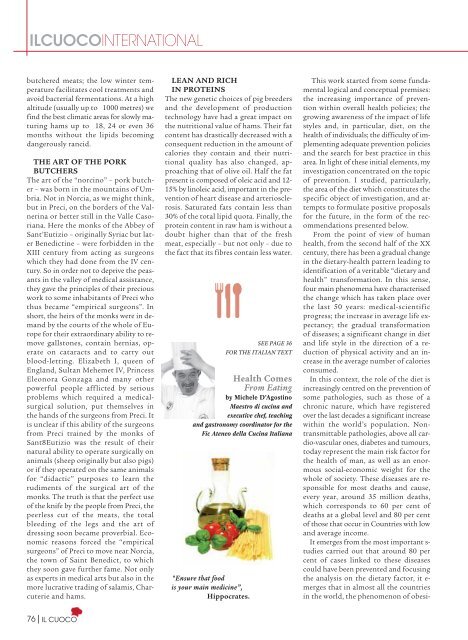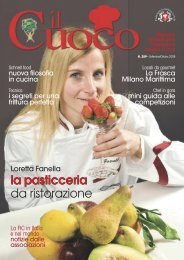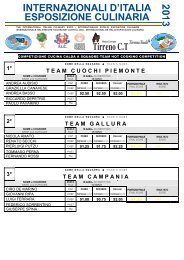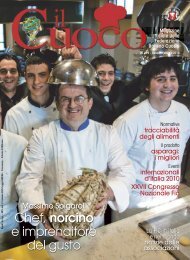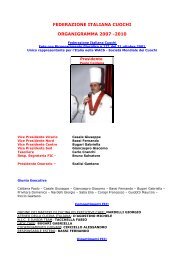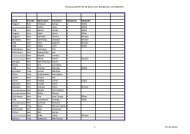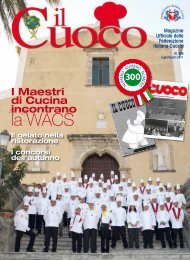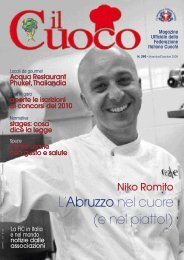Scarica versione PDF - Federazione Italiana Cuochi
Scarica versione PDF - Federazione Italiana Cuochi
Scarica versione PDF - Federazione Italiana Cuochi
You also want an ePaper? Increase the reach of your titles
YUMPU automatically turns print PDFs into web optimized ePapers that Google loves.
ILCUOCOINTERNATIONALThis work started from some fundamentallogical and conceptual premises:the increasing importance of preventionwithin overall health policies; thegrowing awareness of the impact of lifestyles and, in particular, diet, on thehealth of individuals; the difficulty of implementingadequate prevention policiesand the search for best practice in thisarea. In light of these initial elements, myinvestigation concentrated on the topicof prevention. I studied, particularly,the area of the diet which constitutes thespecific object of investigation, and attemptsto formulate positive proposalsfor the future, in the form of the recommendationspresented below.From the point of view of humanhealth,fromthesecondhalfoftheXXcentury, there has been a gradual changein the dietary-health pattern leading toidentification of a veritable “dietary andhealth” transformation. In this sense,four main phenomena have characterisedthe change which has taken place overthe last 50 years: medical-scientificprogress; the increase in average life expectancy;the gradual transformationof diseases; a significant change in dietand life style in the direction of a reductionof physical activity and an increasein the average number of caloriesconsumed.In this context, the role of the diet isincreasingly centred on the prevention ofsome pathologies, such as those of achronic nature, which have registeredover the last decades a significant increasewithin the world’s population. Nontransmittablepathologies, above all cardio-vascularones, diabetes and tumours,today represent the main risk factor forthe health of man, as well as an enormoussocial-economic weight for thewholeofsociety.Thesediseasesareresponsiblefor most deaths and cause,every year, around 35 million deaths,which corresponds to 60 per cent ofdeaths at a global level and 80 per centof those that occur in Countries with lowand average income.It emerges from the most important s-tudies carried out that around 80 percent of cases linked to these diseasescould have been prevented and focusingthe analysis on the dietary factor, it e-merges that in almost all the countriesin the world, the phenomenon of obesibutcheredmeats; the low winter temperaturefacilitates cool treatments andavoid bacterial fermentations. At a highaltitude (usually up to 1000 metres) wefind the best climatic areas for slowly maturinghams up to 18, 24 or even 36months without the lipids becomingdangerously rancid.THE ART OF THE PORKBUTCHERSThe art of the “norcino” – pork butcher– was born in the mountains of Umbria.Not in Norcia, as we might think,butinPreci,onthebordersoftheValnerinaor better still in the Valle Casoriana.Here the monks of the Abbey ofSant’Eutizio – originally Syriac but laterBenedictine – were forbidden in theXIII century from acting as surgeonswhich they had done from the IV century.So in order not to deprive the peasantsin the valley of medical assistance,they gave the principles of their preciouswork to some inhabitants of Preci whothus became “empirical surgeons”. Inshort, the heirs of the monks were in demandby the courts of the whole of Europefor their extraordinary ability to removegallstones, contain hernias, operateon cataracts and to carry outblood-letting. Elizabeth I, queen ofEngland, Sultan Mehemet IV, PrincessEleonora Gonzaga and many otherpowerful people afflicted by seriousproblems which required a medicalsurgicalsolution, put themselves inthe hands of the surgeons from Preci. Itis unclear if this ability of the surgeonsfrom Preci trained by the monks ofSant8Eutizio was the result of theirnatural ability to operate surgically onanimals (sheep originally but also pigs)or if they operated on the same animalsfor “didactic” purposes to learn therudiments of the surgical art of themonks. The truth is that the perfect useof the knife by the people from Preci, thepeerless cut of the meats, the totalbleeding of the legs and the art ofdressing soon became proverbial. Economicreasons forced the “empiricalsurgeons” of Preci to move near Norcia,the town of Saint Benedict, to whichthey soon gave further fame. Not onlyas experts in medical arts but also in themore lucrative trading of salamis, Charcuterieand hams.LEAN AND RICHIN PROTEINSThe new genetic choices of pig breedersand the development of productiontechnology have had a great impact onthe nutritional value of hams. Their fatcontent has drastically decreased with aconsequent reduction in the amount ofcalories they contain and their nutritionalquality has also changed, approachingthat of olive oil. Half the fatpresent is composed of oleic acid and 12-15% by linoleic acid, important in the preventionof heart disease and arteriosclerosis.Saturated fats contain less than30% of the total lipid quota. Finally, theprotein content in raw ham is without adoubt higher than that of the freshmeat, especially – but not only – due tothe fact that its fibres contain less water.SEEPAGE36FOR THE ITALIAN TEXTHealth ComesFrom Eatingby Michele D’AgostinoMaestro di cucina andexecutive chef, teachingand gastronomy coordinator for theFic Ateneo della Cucina <strong>Italiana</strong>"Ensure that foodis your main medicine”,Hippocrates.76|


